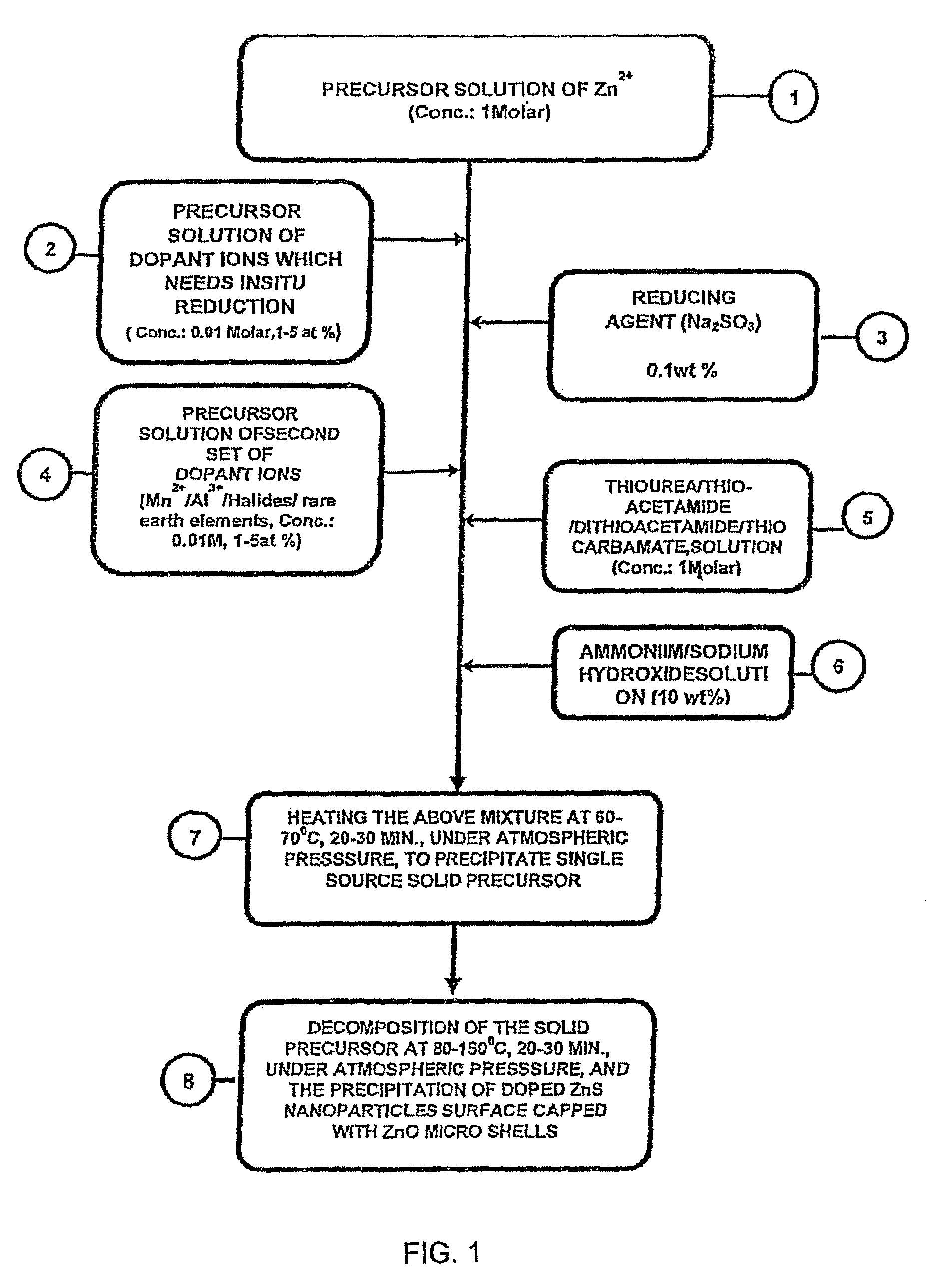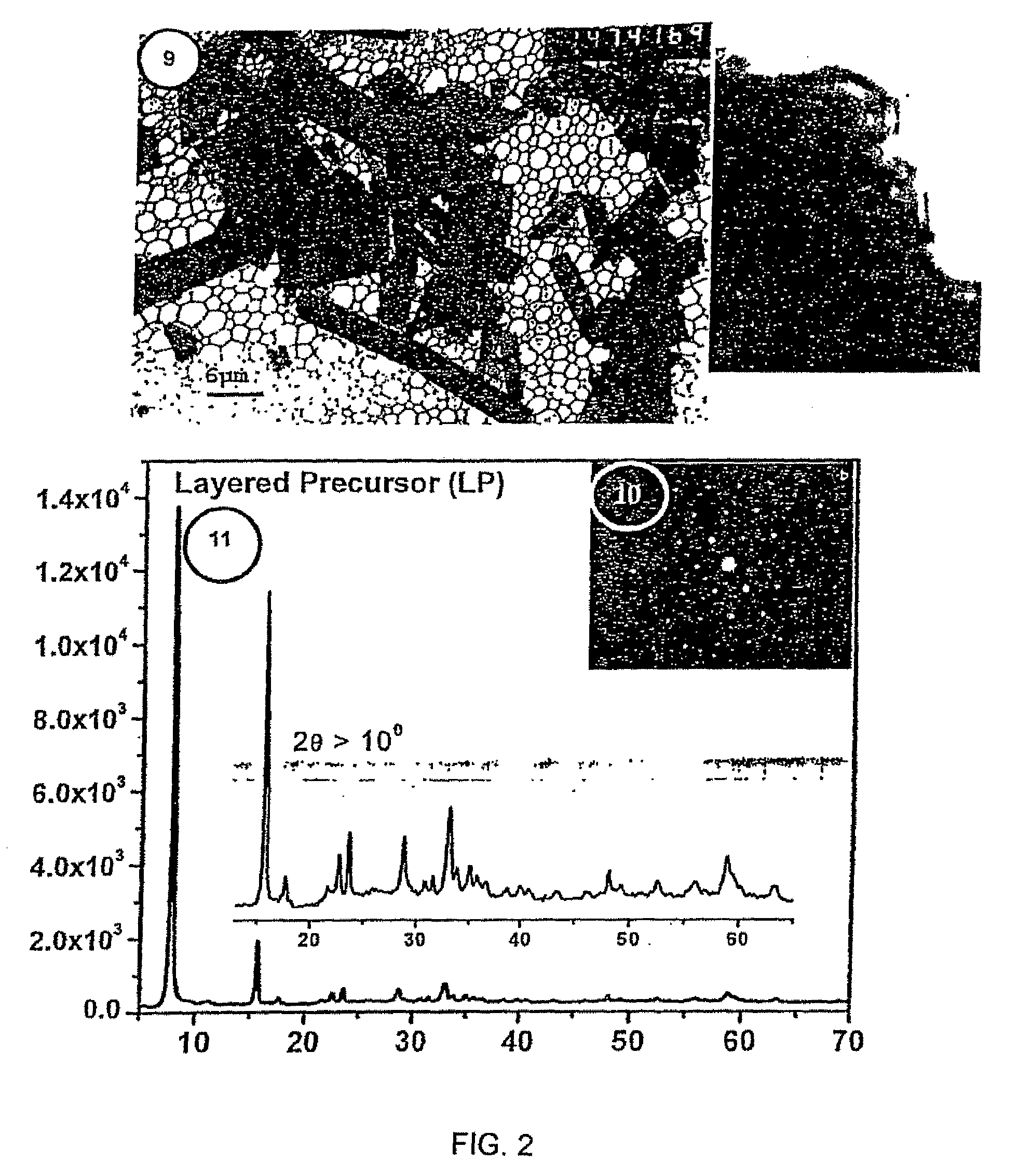Single-source precursor for semiconductor nanocrystals
a semiconductor nanocrystal and single-source technology, applied in the direction of conductors, cellulosic plastic layered products, other chemical processes, etc., can solve the problems of toxic nature of surface capping agents such as mercaptoacetic acid, mercaptoethanol, etc., to achieve high luminescence efficiency, facilitate efficient, and increase luminescence quantum efficiency
- Summary
- Abstract
- Description
- Claims
- Application Information
AI Technical Summary
Benefits of technology
Problems solved by technology
Method used
Image
Examples
example 1
Synthesis of Green Emitting Nanocrystals in Aqueous Medium
[0058]For the preparation of nanocrystals, 500 ml of IM zinc sulfate aqueous solution is mixed homogenously with 50 ml of 0.01M copper acetate (1 at % Cu2+) solution and 10.0 mg of anhydrous Sodium Sulphite Powder. The mixture thus obtained is added with 100 ml of 0.01 M aluminum nitrate solution (2 at % Al3+) and 500 ml of I M thiourea. In the next step NH4OH solution is added until the pH of the reaction mixture raises to 10-11, which is heated to 60-70° C. for a period of 20-30 minutes to obtain a white precipitate which is filtered and subsequently washed and dried at 50-60° C. for its storage. Alternatively, the precipitate is decomposed in the mother-liquor by increasing the temperature to 100-110° C. for a period of 15-17 minutes. Further, alternatively, Teflon-lined reactor (autoclave) may also be used for the heat treatment of the precipitate at a temperature of 100-110° C. The precipitate thus treated is subjected t...
example 2
Synthesis of Yellow Emitting Nanocrystals in Aqueous Medium
[0059]For the preparation of nanocrystals, 500 ml of IM zinc sulfate aqueous solution is mixed homogenously with 50 ml of 0.01 copper acetate (1 at % Cu2+) solution and 10.0 mg of anhydrous Sodium Sulphate Powder. The mixture thus obtained is added with 100 ml of 0.01 M aluminum nitrate solution (2 at % Al3+) and 500 ml of I M thiourea. In the next step NH4OH solution is added until the pH of the reaction mixture raises to 10-11, which is heated to 60-70° C. for a period of 20-30 minutes to obtain a white precipitate. This solid-precursor is either separated and stored for use or decomposed by increasing the temperature of reaction medium to 110-130° C. for a period of 15-17 minutes to obtain precipitate containing the doped nanocrystals Further, alternatively, Teflon-lined reactor (autoclave) may also be used for the heat treatment of the precipitate at a temperature of 110-130° C., which is filtered, washed and dried of 70...
example 3
Synthesis of Orange Emitting Nanocrystals in Aqueous Medium
[0060]For the preparation of nanocrystals, 500 ml of 1M zinc sulfate aqueous solution is mixed homogenously with 50 ml of 0.01M copper acetate (1 at % Cu2+) solution, and 10.0 mg of anhydrous sodium sulphite powder. The mixture thus obtained is added with 100 ml of 0.01M aluminum nitrate solution (2 at % Al3+), 50 ml of 0.001M manganese sulphite (MnSO4 n H2O) and 500 ml of 1M thiourea. In the next step, 5% solution of NH4OH or NaOH solution is added until the pH of the reaction mixture raises to ˜9, which is heated to ˜60-70° C. for a period of 20-30 minutes, under atmospheric pressure, to obtain a white precipitate which is decomposed in air or water at 130-140° C. to generate Cu+—Mn2+—Al3+ doped ZnS nanoparticles covered with ZnO shell. The precipitate thus obtained is filtered, washed and dried at 70-80° C. The nanocrystals thus obtained shows bright orange luminescence at 590 nm, the yield of which is ˜90% and the same i...
PUM
| Property | Measurement | Unit |
|---|---|---|
| temperature | aaaaa | aaaaa |
| temperature | aaaaa | aaaaa |
| boiling point | aaaaa | aaaaa |
Abstract
Description
Claims
Application Information
 Login to View More
Login to View More - R&D
- Intellectual Property
- Life Sciences
- Materials
- Tech Scout
- Unparalleled Data Quality
- Higher Quality Content
- 60% Fewer Hallucinations
Browse by: Latest US Patents, China's latest patents, Technical Efficacy Thesaurus, Application Domain, Technology Topic, Popular Technical Reports.
© 2025 PatSnap. All rights reserved.Legal|Privacy policy|Modern Slavery Act Transparency Statement|Sitemap|About US| Contact US: help@patsnap.com



